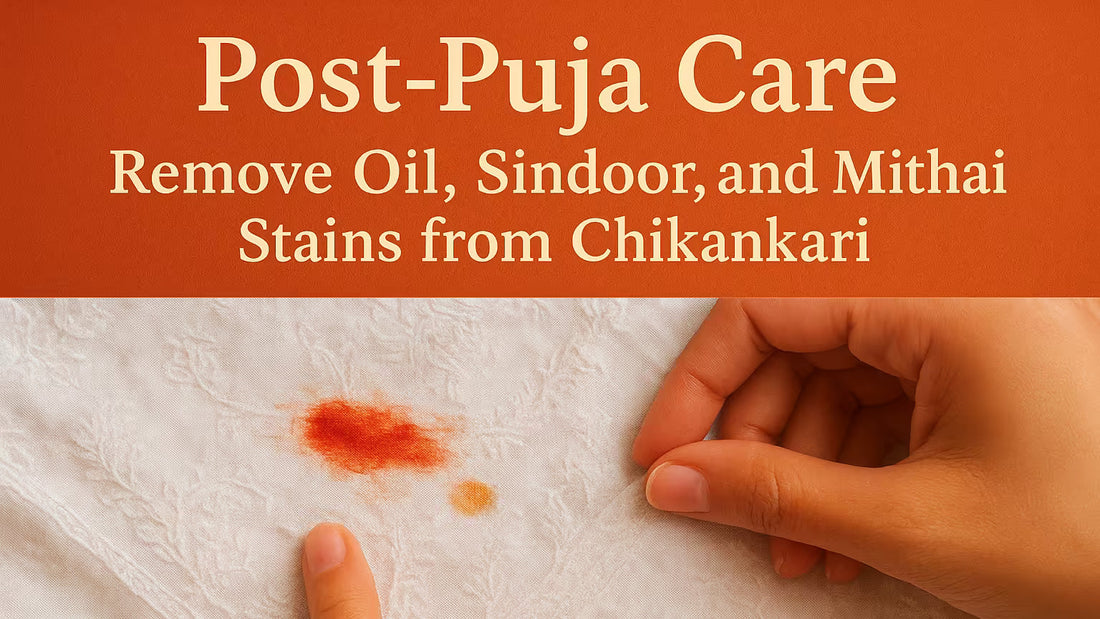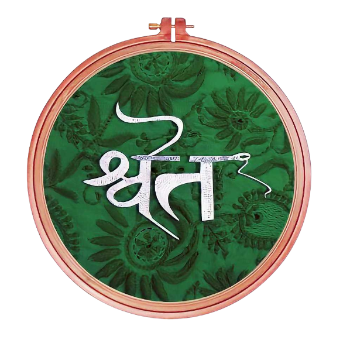
Post-Puja Care: Remove Oil, Sindoor, and Mithai Stains from Chikankari
Share
Festivals light up the home and the wardrobe. They can also leave tiny souvenirs on your outfits—oil splashes from diyas, a touch of sindoor, a drip of syrup from mithai. With hand-embroidered Chikankari, the goal is simple: clean the stain without flattening stitches or stressing fine fabrics. This guide shows you exactly how, using low-heat, fabric-safe steps you can do at home.
Golden rules before you start
Cold water first. Heat sets pigments and oils.
Blot, don’t rub. Rubbing pushes color into threads and distorts embroidery.
Work from the back. Push the stain out through the fabric.
Test every agent. Try on an inner seam or hem.
Air-dry between rounds. Heat only after the mark is fully gone.
Know your fabric
Cotton / Muslin: Most forgiving; tolerates short soaks and oxygen bleach (after a patch test).
Modal / Rayon: Smooth drape; treat gently and avoid vigorous rubbing.
Georgette / Organza: Sheer and delicate; dab only, no twisting.
Mukaish / Zardozi zones: Keep liquids off metal work; treat the surrounding cloth and wick toward the spot with a cotton bud.
Oil stains (diyas, ghee, fried foods)
What happens: Oil spreads fast and leaves a dark halo on light fabrics.
What to do now
1. Blot with tissue. Do not rub.
2. Absorb: Cover with talcum powder or cornstarch for 15–30 minutes; brush off.
3. Lift: Place the area face-down on paper towel. Dab the back with a drop of mild dish liquid + cold water using a cotton bud.
4. Rinse cold, repeat if a shadow remains.
5. Wash gently with a delicate detergent. Air-dry flat in shade.
Embroidery tip: Slide a thin cloth under the panel while dabbing so water doesn’t spread into stitches.
Sindoor / kumkum stains
What happens: Oil-based pigments bite into light colors.
Dry first
1. Shake or tap off loose powder. Keep water away at this stage.
2. Lay fabric face-down on paper towel.
Two safe approaches (patch test required)
Option A (gentle): Dab from the back with isopropyl alcohol 70% on a cotton bud in small circles. Replace paper towel as it wicks color. Rinse cold, then mild-detergent wash.
Option B (cotton only): Dab a mix of lemon juice + cold water sparingly, then rinse cold and wash. Avoid on silk-blend and near metal work.
Avoid: Hot water and aggressive scrubbing. They set the stain.
Mithai, sugar syrup, tea/coffee drips
What happens: Sugar leaves a sticky residue; ghee in fillings can add oil.
Steps
1. Dissolve sugars: Rinse the back with cold water.
2. Soak 10 minutes in lukewarm (not hot) water + mild detergent.
3. De-ring: If a faint ring remains, dab white vinegar:water = 1:3, then rinse cold.
4. Air-dry; repeat once if needed.
Haldi / turmeric touch-ups
What happens: Curcumin bonds with fabric and darkens in sun.
Steps
1. Flush from the back with cold running water immediately.
2. Pre-treat: Spread a thin film of glycerin or mild dish liquid for 10–15 minutes.
3. Rinse cold, then gentle wash.
4. Dry indoors. Sunlight can set turmeric; take it outside only after the stain is gone.
5. Next-day pass: Turmeric often fades further after a second light wash.
Makeup smudges (lipstick, kajal)
Lipstick: Dab from the back with micellar water or 70% alcohol; rinse cold and wash.
Kajal/liner: Dust cornstarch for 10 minutes, brush off, then dab dish liquid + cold water and rinse.
Aftercare: wash and dry the Chikankari way
1. Turn inside out. Use a mesh bag for machine delicate cycles.
2. Cold water, short cycle, mild liquid detergent. Skip fabric softener.
3. Press water out in a towel. No wringing.
4. Dry flat in shade. Reshape edges with fingers.
5. Iron on reverse on low heat or steam lightly from a distance, avoiding metal embellishment.
Prevention during rituals
Wear a light cotton dupatta or apron while lighting diyas.
Keep a white napkin and cotton buds handy for quick dabbing.
Pre-treat brand-new outfits with a fabric protector that is safe for cotton and silk blends (patch test first).
Seat oil lamps on trays to catch splashes.
When to use a professional cleaner
Large oil spills that spread fast.
Old, heat-set sindoor or haldi stains.
Dense mukaish or zardozi panels where moisture can tarnish metal.
Ask for: Solvent spot-treat only, no chlorine, and a low-heat finish. Share the fabric type (cotton, modal, georgette).
Quick FAQ
Can I use baking soda on everything?
No. On sheer fabrics it can leave a chalky cast. Prefer talc/cornstarch for oil and a mild detergent for washing.
Is vinegar universal?
Use it for sugar residues and some dye rings. Avoid on fresh turmeric and away from metal work.
The stain lightened but didn’t vanish. What now?
Air-dry, then repeat the same gentle method once more. Escalate only after two mild rounds.
At Shwet Artistry
Every piece is hand-embroidered and deserves the same gentleness at home. Think of your fabric as alive: when you use cold water, mild agents, and patience, Chikankari rewards you with years of graceful wear.
